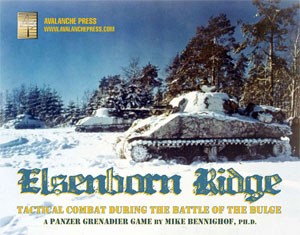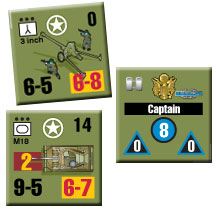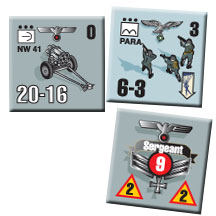| Elsenborn
Ridge:
Scenario Preview, Part Four
By Mike Bennighof,
Ph.D.
June 2020
 The very act of writing history is, in itself, a political act. You can’t “just state the facts”; for starters, there are way too many facts, about any event, to state them all. You have to choose which ones are worth stating and with that choice opinion enters the arena. Hopefully it’s well-informed and judicious opinion, expert opinion even, but history is not mathematics. There are no cold universal truths. Well, not many, anyway. The very act of writing history is, in itself, a political act. You can’t “just state the facts”; for starters, there are way too many facts, about any event, to state them all. You have to choose which ones are worth stating and with that choice opinion enters the arena. Hopefully it’s well-informed and judicious opinion, expert opinion even, but history is not mathematics. There are no cold universal truths. Well, not many, anyway.
One of those universal truths, in my universe, is that Nazis are and were just plain evil. I chose to design Panzer Grenadier: Elsenborn Ridge because the battle was a prime example of the United States Army taking a terrible blow from a force of evil, standing its ground, and then throwing back the minions of an evil master.
We hold these truths to be self-evident: That all men are created equal.
Nineteen thousand American soldiers gave their lives in the bitter cold of Belgium and Luxembourg to uphold that sacred principle. Let’s take a look at a few more of their great deeds.
Scenario Twenty-Six
Parker's Crossroads
23 December 1944
Maj. Arthur C. Parker of the 598th Field Artillery Battalion found himself guarding the crossroads of Baraque de Fraiture with three howitzers and their crews, the only roadblock stopping the fresh 2nd SS Panzer Division from driving deep into the American rear along Highway N-15 to unravel the defenses to the north and block the coming counter-offensive. Ordered to a rest area to help re-constitute the shattered 106th Infantry Division, Parker ignored the Army's bureaucracy and instead began gathering scattered pieces of other units as they went past - anti-aircraft gunners, cavalrymen, and glider infantrymen. Finally the 82nd Airborne and 3rd Armored Divisions sent what few reserves they had to help hold the crossroads, just in time to face the SS assault.
Conclusion
The Americans fought hard, but with little cohesion thanks to the presence of troops from three different divisions (3rd Armored, 82nd Airborne and 106th Infantry) and at least three independent battalions. The defenders held up the SS throughout the night - a vital task, as the Germans dared not move by daylight now that the weather had cleared enough for Allied airpower to join the fray - but crumbled by dawn and a regimental commander of 82nd Airborne authorized a withdrawal. Thanks to the confused command structure many American units never received this order, and casualties are impossible to determine but were severe. The road to Liege, the major realistic German objective, lay open but 2nd SS Panzer lacked both the fuel and the command competence to exploit their victory.
Notes
It’s going to be a hard afternoon and night for the heroes, with restrictions on how the Americans can move (since they come from a bajillion different units) but they still can fire just fine. The only artillery support they have is what’s on the board, which isn’t much, while the Nazi scum have halftracks for their infantry, tank support and artillery backing. Bet on the red, the white and the blue anyway.
Scenario Twenty-Seven
Christmas Gift
25 December 1944
 The raw 75th Infantry Division arrived at the front on Christmas Eve and was immediately flung into action. A German tank column quickly broke through their lines and was only stopped by a lucky bazooka shot that knocked out a Panther so that the burning wreck it blocked the road. The next day the green infantrymen received air and armor support, and an order to attack the dreaded SS at the village of Grandmenil. The raw 75th Infantry Division arrived at the front on Christmas Eve and was immediately flung into action. A German tank column quickly broke through their lines and was only stopped by a lucky bazooka shot that knocked out a Panther so that the burning wreck it blocked the road. The next day the green infantrymen received air and armor support, and an order to attack the dreaded SS at the village of Grandmenil.
Conclusion
Third Armored Division's Task Force McGeorge had laid out its orange recognition panels properly, but the P38 Lightnings of 430th Fighter Squadron attacked them anyway, killing 38 men and wounding dozens more. The "American Luftwaffe" thoroughly crushed the attack and the SS had no problem driving back the handful of green riflemen who tried to advance without the tanks. Grandmenil would fall on the 26th to the same American forces - but without air support.
Notes
The American tankers are pretty tough; they’re from Spearhead, after all. The new infantrymen are not so determined, and there’s a 50-50 chance that any American planes that show up will attack them instead of the Nazi criminals. Those SS Panthers are going to be hard to deal with, but Spearhead’s 76mm-armed Shermans can take them if they work onto their flanks.
Scenario Twenty-Eight
Boxing Day
26 December 1944
Recovered from the deadly "friendly fire" incident of Christmas Day with additional tank reinforcements on their way, Task Force McGeorge made ready to resume its attack on Grandmenil. Meanwhile the SS prepared to renew their own attack up the road to Erezee where they had been stopped by the green troops of the 75th Infantry Division. The two attacking forces met on the day after Christmas.
Conclusion
The two forces crashed together, with the Panthers getting much the better of the tank duel. But the SS grenadiers had suffered terrible losses among their junior officers and lost much of their unit cohesion. Timely reinforcements made the difference, and it was the Germans who fell back as American tanks captured Grandmenil. Capt. John Jordan and his crew joined the attack after having spent the night near the village - trapped behind enemy lines, Jordan simply parked his tank next to several burned or abandoned Shermans and the SS men never examined them. When the Americans returned to Grandmenil, Jordan radioed in reports of German movements and when his own division's tanks drew close he joined them.
Notes
We have a replay of the previous scenario, but this time the Americans have more tanks, more artillery, and a spotter hidden behind the German lines. The new guys are still pretty green, but the Spearhead always pushes through.
Scenario Twenty-Nine
The Small Solution
27 December 1944
 While top American generals like Omar Bradley, George Patton and Matthew Ridgway urged Gen. Dwight D. Eisenhower to attack out of the Elsenborn Ridge area and cut off the two German panzer armies, Ike chose a more cautious approach. The counter-offensive would take place farther to the west, with less risk but of course a lesser potential reward - a choice derided by Eisenhower's counterpart, Field Marshal Gerd von Rundstedt, as the "Small Solution." One of the first of these attacks fell on the 9th SS Panzer Division. A favored unit, the division had meandered through the German rear areas since the offensive's start and suffered many more losses to American planes than in ground combat. While top American generals like Omar Bradley, George Patton and Matthew Ridgway urged Gen. Dwight D. Eisenhower to attack out of the Elsenborn Ridge area and cut off the two German panzer armies, Ike chose a more cautious approach. The counter-offensive would take place farther to the west, with less risk but of course a lesser potential reward - a choice derided by Eisenhower's counterpart, Field Marshal Gerd von Rundstedt, as the "Small Solution." One of the first of these attacks fell on the 9th SS Panzer Division. A favored unit, the division had meandered through the German rear areas since the offensive's start and suffered many more losses to American planes than in ground combat.
Conclusion
The 9th SS lost both villages and reported that one of its grenadier regiments had been "cut to pieces." Even though the paratroopers lacked tank support, they had powerful artillery behind them and considerable attitude. The SS corps commander informed army headquarters that 9th SS was no longer capable of combat operations and requested that it be withdrawn. The request was denied; for once, even the favored SS would be left in the front lines just like the regular army divisions.
Notes
It’s going to be a bad day to be a war criminal; the Nazi scum have tanks and some artillery support while the Americans have none. But All-American morale is sky-high, the heavy snow makes tanks harder to use anyway, and there’s a massive steel rain of artillery coming down onto the unrighteous made even deadlier with the VT fuze.
Scenario Thirty
People's Grenadiers
28 December 1944
On the northern flank of the German Ardennes offensive, the stout American defense of the twin villages and other locations totally disrupted German plans. The German command removed all panzer and panzer grenadier divisions from this flank, but the American salient at Wirtzfeld jutting into the German lines remained a danger due to the heavy American artillery concentration on the Elsenborn Ridge. After a delay of several days, Gen. Otto Hirtzfeld sent the remains of his 67th Corps forward.
Conclusion
The American artillery on Elsenborn Ridge was not packed wheel-to-wheel as junior officers told their men, but it came close. Without the proximity fuze it had been deadly to Germans in the open, but now the clear fields between the twin villages and the Elsenborn Ridge became a killing ground. The Volksgrenadiers lost hundreds of men and did not come close to the American positions.
Notes
There’s not a lot of American infantry to hold their ground, while the German “Water Buffalo” Division has plenty of troops. They’re going to need them, since they have to cross open ground under a massive artillery barrage armed with the deadly VT fuze. This is going to be a black day for the German Army.
And that’s the fourth segment. Next time we’ll wrap it up.
Click
here to order Elsenborn Ridge right
now!
Sign up for our newsletter right here. Your info will never be sold or transferred; we'll just use it to update you on new games and new offers.
Mike Bennighof is president of Avalanche Press and holds a doctorate in history from Emory University. A Fulbright Scholar and NASA Journalist in Space finalist, he has published over 100 books, games and articles on historical subjects.
He lives in Birmingham, Alabama with his wife, three children and his dog, Leopold.
|
